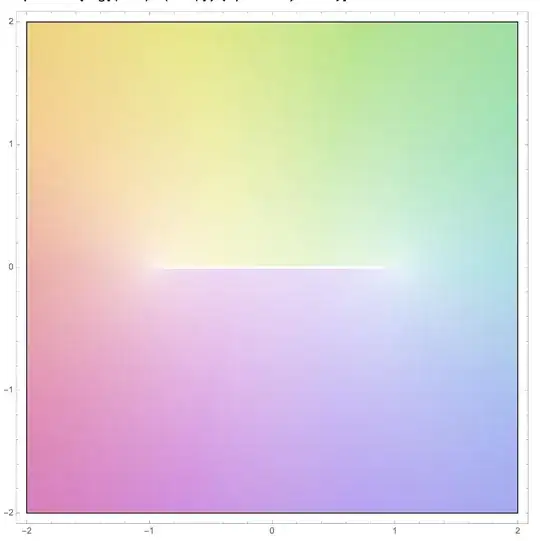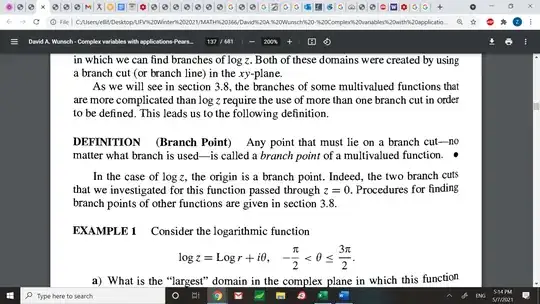$\log$ is "always" multivalued, as $\log(x)\sim \log(x) + 2\pi i$, regardless of what $x \;(\neq 0)$ is! One question, though, is whether you always need a branch cut. One way of showing that you need a branch cut is by showing that for a family of mutually nonintersecting closed curves, the function is locally holomorphic but not possibly analytic on each of those curves. One way to do that (at least sometimes) is to phrase your function as the antiderivative of another function along those curves, and then show that the value at a given point on each of those curves is not well-defined.
That is, the integral of the derivative of $f$ around each of those curves—which should be the difference between $f$ at the beginning and end, which here are the same point, and therefore should be $0$—is actually nonzero. Here, $f(z)=\log\left(\frac{z-1}{z+1}\right)$ and $f'(z)=\frac{1}{z-1}-\frac{1}{z+1}$.
So, explicitly, for a curve $\gamma^+_{a\mapsto a}$ encircling $z=1$ but not $z=-1$, which starts and ends at $a$:
$$\begin{align}
0 &= \left[\log\left(\frac{z-1}{z+1}\right)\right]_{z=a}^a \\
&= \int_{\gamma^+_{a\mapsto a}}\frac{1}{z-1}-\frac{1}{z+1}\ dz \\
&=\text{res}_{z=1}\frac{1}{z-1} - 0 \\
&=2\pi i
\end{align}$$
Likewise, for a curve $\gamma^-_{a\mapsto a}$ encircling $z=-1$ but not $z=1$:
$$\begin{align}
0 &= \left[\log\left(\frac{z-1}{z+1}\right)\right]_{z=a}^a \\
&= \int_{\gamma^-_{a\mapsto a}}\frac{1}{z-1}-\frac{1}{z+1}\ dz \\
&=0 - \text{res}_{z=-1}\frac{1}{z+1} \\
&=-2\pi i
\end{align}$$
So, $f$ cannot be (single-valued) analytic on any domain containing such curves, lest we get a contradiction. If a (sufficiently nice) branch cut, therefore, did not include $-1$ and did not include $1$, we could arrive at a contradiction by going sufficiently close to one of those and repeating the above. So, $-1$ and $1$ need to be in every (sufficiently nice) branch cut. (There's a little more technical reasoning we could do here, but I'm guessing your text allows certain assumptions on what a "line" is or gives proof techniques for finding branch points that are a bit simpler than that would involve.)
These are the only branch points: after choosing a branch cut, we can define $\log\left(\frac{z-1}{z+1}\right)$ to be the integral of $\frac{1}{z-1}-\frac{1}{z+1}$ along some path to the point in question, plus whatever integer multiple of $2\pi i$ we like.
Let's construct a nice branch cut: the interval $[-1,1]$. Note that we get no contradiction by encircling the whole branch cut with a curve, since the residues cancel out. This is what we get by using the principal branch of $\log$ in our definition. Here's what $f$ looks like with that branch cut:

We could also choose many other branch cuts, of course, as long as they include $-1$ and $1$ (including the branch cut with "disconnected" branches $(-\infty,-1]$, $[1,\infty)$) and as long as the resulting branch satisfies $e^{f(z_0)}=\frac{z_0-1}{z_0+1}$ at some point $z_0$.
Takeaway message: you can usually expect $\log$ to be multivalued, and to require a branch cut whenever there's a pole somewhere, since integrating the derivative around that pole will likely give you a residue.
As for getting the real and imaginary parts, it depends on your branch cut! If you use the principal branch of $\log$, you can break it up as $\log\left|\frac{z-1}{z+1}\right|+i\arg\left(\frac{z-1}{z+1}\right)$—and then if you want to simplify those in terms of $z=re^{i\theta}$, you might want to do some trig.
Let me know if anything here is unclear!

